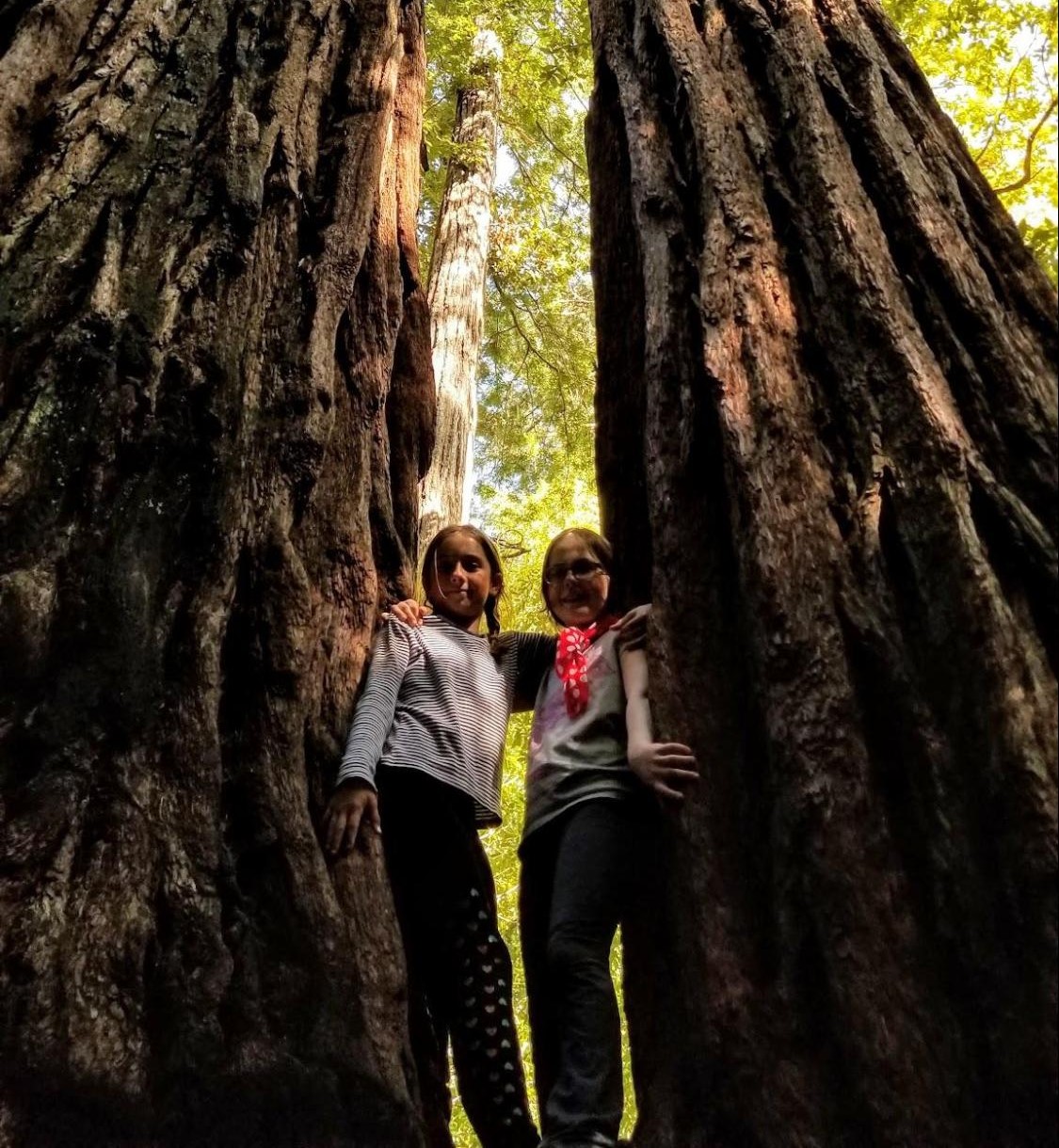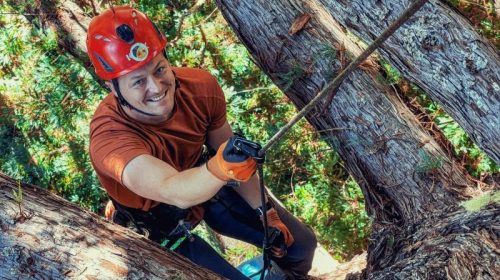Why Trees (and Human Spirits) Endure
Nature builds resilience into our bark
By Jane Mulcaster
Girl Scouts Meg Mulcaster, Narya Bower, and Maggie Fry from Campbell troop 62301 explore fire-scarred redwoods outside the Big Basin Visitor Center in April, 2018.
As the sun sank behind the trees at the upper campground in Big Basin State Park in early April 2018, the mercury dipped into the 40s, making many members of Girl Scout Troop 62301 and their families wish that they’d brought more clothes.
A small band of us trooped down to the Visitor Center to get more marshmallows. The historic center was built in 1936 by the Civilian Conservation Corps as part of President Franklin Roosevelt’s New Deal. On that chilly April afternoon, the Center’s rough-hewn edifice and wooden glass-paned doors welcomed us into its cozy cabin atmosphere. I think there was even a fire burning on the hearth. I found a pair of fleece-lined gloves that saved my campfire experience that night.
A ring of redwood trees next to the parking lot, scarred by past fires, made a maze of nooks and crevices where our Girl Scouts played like squirrels, a testament to the enduring spirit of life.
And then, fire
On August 20, 2020, The Mercury News reported that when the CZU Lightning Complex fire tore through the park on August 18th, nearly all of Big Basin’s iconic redwood trees were scorched, and while many survived the blaze with foliage intact, dozens near the park center had been torched up to the crown.
I don’t know what the fate will be of the individual trees we played among in 2018, but redwood trees are naturally resistant to fire because they are high in tannin and produce little resin or pitch. Once damaged by fire, redwoods readily sprout new branches or even a whole new crown. If an individual tree is too damaged, its communal root system quickly generates new buds.
Structures are not so naturally equipped. Houses catch fire by flying embers, radiant heat, or direct flames, according to the University of California Cooperative Extension website Fire in California. Embers destroy homes because they can gather in drifts, like snow, and quickly ignite dry leaves and pine duff on roof crevices and in gutters. They can blow into roof vents or open windows to consume the house from inside. They can also ignite leaf litter around the house, which can torch bigger fuels that consume structures.
The fire that consumed the Big Basin Visitor Center appears to have borne down with high intensity. Unlike some areas where a house is reduced to ash while the surrounding foliage is lightly scorched, everything around the park’s headquarters appears to be blackened.
Reality and a new normal that is yet to emerge
Although hundreds of hotspots still smoulder, Cal Fire just proclaimed the CZU fire, ignited by an electrical storm on August 16, fully contained on September 22. Thirty Seven days, 86,509 acres, 925 homes, and one human life later.
The fire in the midst of Covid-19 was a manifest crisis that seared home the reality that the world we knew is a memory. The fire will scar our memories, just as it has scarred the landscape, for years to come. But even in its scarred state, the beauty of the forest endures. And we, like the roots of the redwoods, will sprout new life.
At the end of our camping weekend in 2018, even though we’d already packed up our gear, we weren’t quite ready to go. The Big Basin Nature Museum & Research Center parted the curtains into the lives of many of Big Basin’s wildlife species, usually hidden to the casual traveler. I was mesmerized by the topographic scale model of the Big Basin watershed sculpted artfully from hardwood. At the time of the fire, the Nature Museum was undergoing an ambitious renovation, launched around the time of our visit in 2018, a $1.1 million joint project of the Mountain Parks Foundation and the Save the Redwoods League. Now, like the Visitor’s Center, its history in ashes, it can only look to a future that is as yet unknown.
Jane Mulcaster writes about government and climate for the San Lorenzo Valley Post.
Photos by Jane Mulcaster. Featured photo Narya Bower and Meg Mulcaster at Big Basin Redwoods State Park before the CZU Lightning Complex Fire.
The San Lorenzo Valley Post is your essential guide to life in the Santa Cruz Mountains. We're dedicated to delivering the latest news, events, and stories that matter to our community. From local government to schools, from environmental issues to the arts, we're committed to providing comprehensive and unbiased coverage. We believe in the power of community journalism and strive to be a platform for diverse voices.





